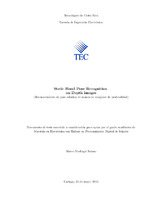Mostrar el registro sencillo del ítem
Reconocimiento de pose estática de manos en imágenes de profundidad
| dc.contributor.advisor | Alvarado-Moya, Pablo | es |
| dc.contributor.author | Madrigal-Solano, Marco | |
| dc.date.accessioned | 2017-06-01T22:14:27Z | |
| dc.date.available | 2017-06-01T22:14:27Z | |
| dc.date.issued | 2015 | |
| dc.identifier.uri | https://hdl.handle.net/2238/7141 | |
| dc.description | Proyecto de Graduación (Maestría en Electrónica) Instituto Tecnológico de Costa Rica, Escuela de Ingeniería Electrónica, 2015. | es |
| dc.description.abstract | With the increasing usage of new technologies in common daily activities, the demand of efficient human-computer interaction (HCI) systems increases. Hand pose recognition systems have been widely explored for such task due to its intuitive operation for non experienced users. However, vision-based hand pose recognition is a extremely challenging problem due to the dynamics of the hand, which poses a large amount of degrees of freedom that makes it difficult to estimate and carries out additional problems such as self occlusion. With the development of reliable and consumer affordable vision systems such as the Microsoft Kinect©, depth imaging has become a useful tool on body parts recognition and thus, for hand recognition. This thesis proposes a static hand pose classification system based on depth images only and considering a top view perspective. No additional constrains to the hand position on the scene are imposed, which allows background objects to be closer to the camera than the hand itself. A synthetically generated data set of four hand postures (open, pointing, fist and pinch) is used. The proposed design is divided in two processing stages: hand segmentation and hand pose classification. The hand segmentation stage uses a random decision forest (RDF) for per-pixel classification of the depth images, segmenting the hand in arm, palm and fingers regions. Hand pose classification is then performed using a defined set of visual features from the labeled blobs. Seven visual features are evaluated in terms of classification accuracy. Two types of classifiers are trained for the pose estimation: random decision forests and support vector machine (SVM) for evaluation purposes. The system proposed provides a 91% of classification accuracy for the defined hand poses on the generated data. | es |
| dc.language.iso | spa | es |
| dc.publisher | Instituto Tecnológico de Costa Rica | es |
| dc.rights | acceso abierto | es |
| dc.subject | Imágenes | es |
| dc.subject | Sistemas hombres máquinas | es |
| dc.subject | Reconocimiento | es |
| dc.title | Reconocimiento de pose estática de manos en imágenes de profundidad | es |
| dc.type | tesis de maestría | es |


